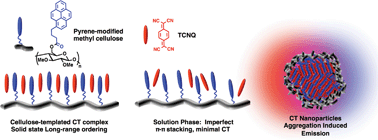Biocompatible organic charge transfer complex nanoparticles based on a semi-crystalline cellulose template†
Abstract
Using a bio-inspired cellulose template, new charge transfer (CT) nanoparticles (NPs) with unique and intriguing emission properties are reported. Pyrene-modified 2,3-di-O-methyl cellulose formed CT complexes with small molecule acceptors, e.g. 7,7,8,8-tetracyanoquinodimethane (TCNQ), and exhibited aggregation-induced emission (AIE) in aqueous medium upon nanoparticle formation. The TCNQ-CT NPs showed multicolor fluorescence emissions at 370–400 nm, 602 nm and 777 nm, when excited at 330 nm, 485 nm and 620 nm respectively. The cellulose-TCNQ NPs are biocompatible and demonstrate an advance in the use of the CT mechanism for biomedical imaging applications both in vitro and in vivo.


 Please wait while we load your content...
Please wait while we load your content...